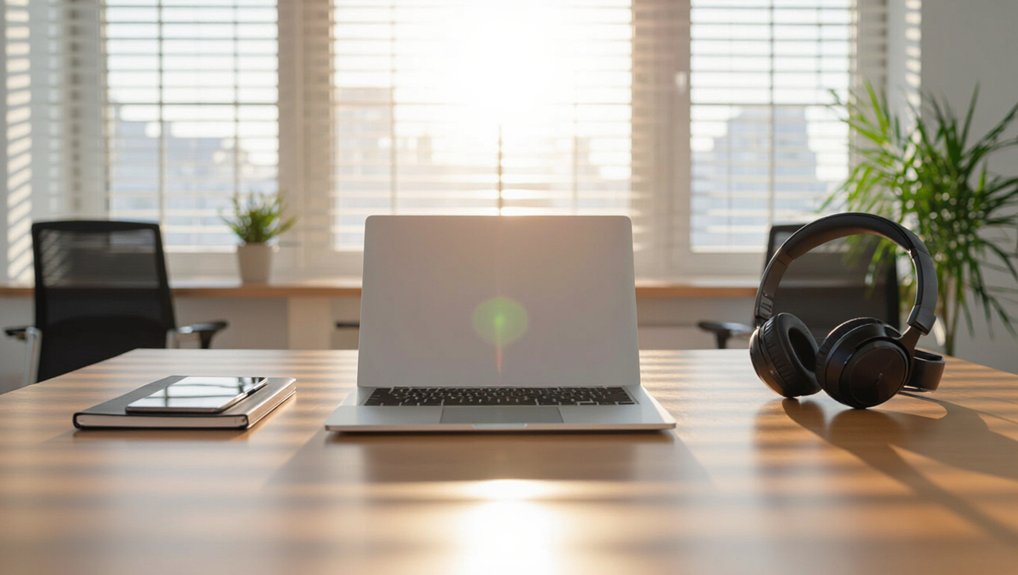You’re halfway through another demanding workday when that familiar mental fog starts creeping in. Your focus wavers, creativity stalls, and even simple tasks feel overwhelming. What if you could completely reset your mind in just five minutes without leaving your desk? This isn’t about escaping your responsibilities—it’s about transforming how effectively you’ll tackle them. The solution lies in a specific meditation technique that works anywhere, even in the busiest office environment.
Why Your Mind Needs a Midday Reset

While your morning coffee may have kickstarted your brain, mental fatigue inevitably creeps in as the day progresses, leaving you feeling scattered and less productive. Your cognitive resources deplete with each decision, email, and meeting you tackle.
This mental fog isn’t just tiredness—it’s your brain’s way of signaling overload.
Research shows you’re operating at significantly reduced capacity by midday. Your attention span shortens, creativity plummets, and stress hormones spike. Without intervention, you’ll continue grinding through tasks ineffectively.
A brief meditation break acts like a mental reset button. It clears accumulated stress, restores focus, and recharges your cognitive batteries.
Just five minutes of mindful breathing can shift your nervous system from fight-or-flight mode back to calm alertness, preparing you for peak afternoon performance.
Setting Up Your Workspace for Meditation

Before you can slip into a meditative state, you’ll need to transform your cluttered workspace into a mini sanctuary. Start by clearing your desk of unnecessary items and paperwork. Close unnecessary browser tabs and silence your phone notifications.
If possible, dim harsh overhead lighting or turn your monitor brightness down. Position yourself comfortably in your chair with your feet flat on the floor and hands resting naturally. You don’t need special equipment—just a clean, quiet space that feels intentional rather than chaotic.
Consider adding one small element that signals “meditation time,” like closing your office door, putting on noise-canceling headphones, or placing a small plant within view.
These simple adjustments create the mental boundary between work mode and mindfulness practice.
The Basic Breathing Technique That Works Anywhere

Three simple breaths can shift your entire nervous system from stress to calm in under a minute.
This technique requires nothing but your attention and works whether you’re sitting at your desk, standing in line, or walking between meetings.
Start by inhaling slowly through your nose for four counts, letting your belly expand naturally.
Hold this breath gently for four counts—don’t force it.
Then exhale completely through your mouth for six counts, releasing tension with each outward breath.
The extended exhale activates your parasympathetic nervous system, signaling your body to relax.
Repeat this 4-4-6 pattern three times minimum.
You’ll notice your shoulders dropping, jaw unclenching, and mind clearing almost immediately.
No apps, no special equipment—just conscious breathing that transforms stress into stillness.
Body Scan Method for Desk-Bound Professionals

Once your breathing has settled your mind, you can address the physical tension that accumulates during long workdays. The body scan method transforms you into a detective of your own physical state, systematically checking each area for stress signals.
Start at your feet and mentally travel upward. Notice if your shoulders are hunched toward your ears—a common desk warrior battle scar.
Feel whether your jaw is clenched or your forehead is furrowed. Don’t try to fix anything yet; simply observe.
When you discover tension, breathe into that specific area and consciously release it. Picture the muscles softening like warm butter.
Your neck, lower back, and wrists typically harbor the most stress from prolonged sitting and typing.
Managing Workplace Distractions During Practice

While office environments rarely offer monastery-like silence, you can still achieve meaningful meditation despite the inevitable interruptions. When colleagues walk by or phones ring, don’t fight these sounds—acknowledge them without judgment and gently return your attention to your breath.
If someone needs to speak with you, simply open your eyes, handle the situation, then resume where you left off.
Use noise-canceling headphones or play soft ambient sounds to create a buffer against distractions. Choose quieter spaces like empty conference rooms or outdoor areas when possible. Signal your unavailability by closing your office door or placing a small sign on your desk.
Remember that distractions aren’t meditation failures—they’re opportunities to practice returning to mindfulness, strengthening your focus muscle.
Dealing With Interruptions From Colleagues

The most challenging aspect of workplace meditation often isn’t internal distractions—it’s well-meaning colleagues who don’t realize you’re taking a mindful break.
You’ll need proactive strategies to minimize these interruptions.
Set clear boundaries by informing your team about your meditation schedule. A simple “I’m taking a five-minute mindfulness break” works wonders.
Post a small sign on your desk or cubicle indicating you’re unavailable. Consider using noise-canceling headphones as a visual cue.
Choose strategic timing when foot traffic’s minimal—early mornings, lunch breaks, or late afternoons often work best.
If someone approaches anyway, politely acknowledge them and ask if it can wait five minutes. Most colleagues will respect your request once they understand you’re engaging in a wellness practice that benefits your productivity.
Signs Your Meditation Break Is Working

After establishing consistent meditation breaks without interruptions, you’ll start noticing concrete changes in your workday experience.
Your stress response becomes more measured when deadlines approach or challenging situations arise. You’ll find yourself pausing before reacting to difficult emails or demanding requests from supervisors.
Physical tension in your shoulders, neck, and jaw decreases throughout the day. Your focus improves during meetings, and you retain information more effectively.
Decision-making becomes clearer as mental clutter reduces. You’ll notice improved patience with coworkers and less irritation from office noise or distractions.
Your energy levels remain steadier without the usual afternoon crashes. Sleep quality often improves, creating a positive cycle where you’re more rested and focused the next day.
Making This Practice a Daily Habit

Building meditation into your daily routine requires strategic timing and consistent commitment rather than perfect conditions. Choose the same time each day—whether mid-morning when energy dips or after lunch when focus wavers.
Set a phone reminder initially, but aim to make it automatic like your coffee break. Start with three days per week if daily feels overwhelming. You’ll build momentum faster with consistency than intensity.
Keep your meditation spot simple: the same chair, earbuds ready, and door closed. Track your practice using a simple calendar checkmark system. When you miss a day, resume immediately rather than waiting for Monday or next month.
Link meditation to existing habits—after checking emails or before afternoon meetings—to create natural triggers that support long-term success.
Adapting the Technique for Different Stress Levels

When stress overwhelms your system, you’ll need to adjust your meditation approach rather than forcing the same technique regardless of your mental state. For mild stress, focus on gentle breathing and body awareness. Count breaths from one to five, then repeat the cycle.
During moderate stress, try progressive muscle relaxation. Tense and release each muscle group for three seconds, starting with your feet and working upward. This helps discharge physical tension.
For intense stress or anxiety, use grounding techniques. Name five things you can see, four you can touch, three you can hear, two you can smell, and one you can taste. This anchors you in the present moment when your mind races.
Remember: there’s no wrong way to meditate when you’re adapting to your current needs.
Building Momentum Beyond the Five-Minute Mark

Once you’ve established a consistent five-minute practice, you’ll naturally want to extend your sessions as meditation becomes more comfortable.
Start by adding just two minutes to your routine, creating seven-minute sessions for a week before progressing further. This gradual approach prevents overwhelm and maintains your motivation.
Schedule longer sessions during lunch breaks or before colleagues arrive. You’ll find deeper states of relaxation and mental clarity emerge around the ten-minute mark.
Don’t abandon your five-minute sessions entirely – they’re perfect for particularly busy days or between meetings.
Track your progress using a meditation app or simple journal. Notice how extended sessions impact your afternoon energy levels, decision-making abilities, and overall workplace satisfaction.
This awareness reinforces the practice’s value and encourages continued growth.
Conclusion
You’ve discovered that five minutes can transform your entire workday. Don’t let this momentum fade – commit to making July 19th the start of your daily meditation practice. You’ll notice improved focus, reduced stress, and enhanced creativity becoming your new normal. Set a daily reminder, protect this time fiercely, and watch as these brief moments of mindfulness ripple through every aspect of your professional life.


